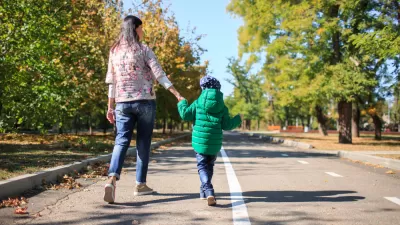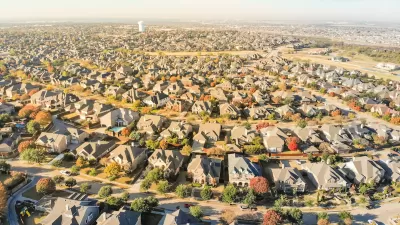For parents of small children, amenities like public restrooms or shady parks can vastly improve—or deteriorate—the experience of navigating cities.

Writing in Streetsblog USA, Barry Greene Jr. outlines five ways that the built environment fails families with young children.
The first problem, Greene writes, is shade. For example: in the warm, humid climate of Greenville, South Carolina, a new city park fails to provide almost any shade. Greene writes that parents and children need shady spots to rest during an outing.
The second issue, for Greene, is public restrooms. Most U.S. cities famously lack a robust network of public bathroom facilities, often turning a walk around a city into an urgent hunt for a bathroom. For parents of toddlers, this is another way their needs are excluded from the public built environment. “Cities are so afraid of our housing insecure that we’ve simply made it inhumane to use the bathroom. Children can’t wait — and sometimes, neither can adults.”
Greene also laments the lack of pedestrianized streets, which create safe spaces for children to run and play, as well as small-scale shops and “micro-retail storefronts” that let parents quickly access daily needs.
Greene’s fifth element of public life that doesn’t cater to parents and children is public transit. “I’ll also include family-friendly ridesharing. Currently, there’s no way to request a rideshare with a child car seat.”
Ultimately, Greene’s advice, aimed at designing cities with children in mind, can make public spaces more safe, pleasant, and accessible to all groups.
FULL STORY: Five Things Missing In The Built Environment For Families With Young Children

Study: Maui’s Plan to Convert Vacation Rentals to Long-Term Housing Could Cause Nearly $1 Billion Economic Loss
The plan would reduce visitor accommodation by 25,% resulting in 1,900 jobs lost.

North Texas Transit Leaders Tout Benefits of TOD for Growing Region
At a summit focused on transit-oriented development, policymakers discussed how North Texas’ expanded light rail system can serve as a tool for economic growth.

Using Old Oil and Gas Wells for Green Energy Storage
Penn State researchers have found that repurposing abandoned oil and gas wells for geothermal-assisted compressed-air energy storage can boost efficiency, reduce environmental risks, and support clean energy and job transitions.

Private Donations Propel Early Restoration of Palisades Playground
Los Angeles has secured over $1.3 million in private funding to restore the Pacific Palisades playground months ahead of schedule, creating a modern, accessible space that supports community healing after recent wildfires.

From Blight to Benefit: Early Results From California’s Equitable Cleanup Program
The Equitable Community Revitalization Grant (ECRG) program is reshaping brownfield redevelopment by prioritizing projects in low-income and environmental justice communities, emphasizing equity, transparency, and community benefits.

Planting Relief: Tackling Las Vegas Heat One Tree at a Time
Nevada Plants, a Las Vegas-based nonprofit, is combating the city’s extreme urban heat by giving away trees to residents in underserved neighborhoods, promoting shade, sustainability, and community health.
Urban Design for Planners 1: Software Tools
This six-course series explores essential urban design concepts using open source software and equips planners with the tools they need to participate fully in the urban design process.
Planning for Universal Design
Learn the tools for implementing Universal Design in planning regulations.
Ascent Environmental
Borough of Carlisle
Institute for Housing and Urban Development Studies (IHS)
City of Grandview
Harvard GSD Executive Education
Toledo-Lucas County Plan Commissions
Salt Lake City
NYU Wagner Graduate School of Public Service





























